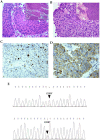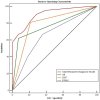Diagnostic roles of proliferative markers in pathological Grade of T1 Urothelial Bladder Cancer
- PMID: 33854611
- PMCID: PMC8040703
- DOI: 10.7150/jca.52336
Diagnostic roles of proliferative markers in pathological Grade of T1 Urothelial Bladder Cancer
Abstract
The stage T1 urothelial bladder cancer (T1 UBC) tumor grade classification is important for prognosis and clinical management. However, the reproducibility of this two-grade classification system is limited in regards to pathological diagnosis, and there is lack of ideal, objective and easily detected markers for pathological diagnosis. In our study, bladder urothelial lesions from a total of 124 patients diagnosed pathologically after transurethral resection of the bladder tumor (TURBT) were collected, including non-cancerous lesions from 33 patients and lesions from 91 T1 UBC patients. A series of previous studies have suggested some common and valuable factors in the diagnosis and prognosis of UBC, but there are still some controversial factors, such as the mitotic figure (MF) of tumor cell, cell proliferation index Ki-67, graded differentiation marker CK20, P53, P504S and carcinogenesis associated telomerase reverse transcriptase (TERT) promoter mutations. The purpose of this study was to evaluate the value of these factors in the pathological grading diagnosis of T1 UBC. The results showed that gender, lesion size, mitotic index (MI), CK20, P53, Ki-67, P504S and TERT promoter hot spot mutations (C228T and C250T) were correlated with T1 UBC diagnosis (P<0.05). The MI, Ki-67 and P504S were correlated with the pathological grade of T1 UBC (P<0.05). Logistic regression analysis showed that the MI and Ki-67 were independent risk factors for high-grade (HG) of T1 UBC (P<0.05). The combined detection of the MI, Ki-67 and P504S in a multivariate diagnostic model improved the diagnostic accuracy of assigning the T1 UBC pathological grade (AUC=0.904, 95%CI: 0.824~0.956, P<0.05). In conclusion, MI and Ki-67, as important markers of histopathology and cell proliferation, can be easily measured and have good reproducibility. These markers may be meaningful parameters for assigning the pathological grade of UBC.
Keywords: Ki-67; mitotic index; telomerase reverse transcriptase promoter mutations; urothelial bladder cancer.
© The author(s).
Conflict of interest statement
Competing Interests: The authors have declared that no competing interest exists.
Figures


Similar articles
-
Telomerase reverse transcriptase promoter mutations in bladder cancer: high frequency across stages, detection in urine, and lack of association with outcome.Eur Urol. 2014 Feb;65(2):360-6. doi: 10.1016/j.eururo.2013.08.052. Epub 2013 Sep 7. Eur Urol. 2014. PMID: 24018021
-
[Urothelial tumor of the urinary bladder: immunohistochemical features].Arkh Patol. 2012 May-Jun;74(3):7-10. Arkh Patol. 2012. PMID: 22937571 Russian.
-
Introduction and first clinical application of a simplified immunohistochemical validation system confirms prognostic impact of KI-67 and CK20 for stage T1 urothelial bladder carcinoma: single-center analysis of eight biomarkers in a series of three hundred six patients.Clin Genitourin Cancer. 2013 Dec;11(4):537-44. doi: 10.1016/j.clgc.2013.05.001. Epub 2013 Jul 10. Clin Genitourin Cancer. 2013. PMID: 23850551
-
Micropapillary Urothelial Carcinoma of the Bladder: A Systematic Review and Meta-analysis of Disease Characteristics and Treatment Outcomes.Eur Urol. 2019 Apr;75(4):649-658. doi: 10.1016/j.eururo.2018.11.052. Epub 2018 Dec 13. Eur Urol. 2019. PMID: 30553613
-
Treatment and management of high-grade T1 bladder cancer: what should we do after second TUR?Jpn J Clin Oncol. 2015 Apr;45(4):315-22. doi: 10.1093/jjco/hyu219. Epub 2015 Jan 12. Jpn J Clin Oncol. 2015. PMID: 25583419 Review.
Cited by
-
Immunotherapeutic Significance of a Prognostic Alternative Splicing Signature in Bladder Cancer.Technol Cancer Res Treat. 2022 Jan-Dec;21:15330338221090093. doi: 10.1177/15330338221090093. Technol Cancer Res Treat. 2022. PMID: 35509211 Free PMC article.
References
-
- van Rhijn BW, Burger M, Lotan Y. et al. Recurrence and progression of disease in non-muscle-invasive bladder cancer: from epidemiology to treatment strategy. Eur Urol. 2009;56:430–442. - PubMed
-
- Flaig TW, Spiess PE, Agarwal N. et al. Bladder Cancer, Version 3.2020, NCCN Clinical Practice Guidelines in Oncology. J Natl Compr Canc Netw. 2020;18:329–354. - PubMed
-
- Babjuk M, Burger M, Comperat EM. et al. European Association of Urology Guidelines on Non-muscle-invasive Bladder Cancer (TaT1 and Carcinoma In situ) - 2019 Update. Eur Urol. 2019;76:639–657. - PubMed
-
- Ravvaz K, Walz ME, Weissert JA. et al. Predicting nonmuscle invasive bladder cancer recurrence and progression in a united states population. J Urol. 2017;198:824–831. - PubMed
LinkOut - more resources
Full Text Sources
Other Literature Sources
Research Materials
Miscellaneous

